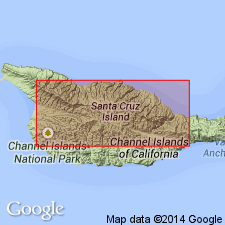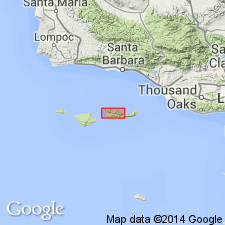
- Usage in publication:
-
- Prisoners Harbor Member
- Modifications:
-
- Named
- Dominant lithology:
-
- Andesite
- Dacite
- Breccia
- Volcaniclastics
- AAPG geologic province:
-
- Santa Maria basin
Summary:
[Named] for Prisoners Harbor. [Type locality} designated as quarry and sea cliffs at Prisoners Harbor, Santa Cruz Island, CA. Is youngest member of Santa Cruz Island Volcanics (new). [Authors say Santa Cruz Island Volcanics informally divided into members.] Consists of fine-grained to glassy andesite and dacite flows and flow breccias, and tuffaceous volcaniclastic beds. Flow rocks are dark gray, weathering to yellow color. Maximum thickness is 600 ft. Discordantly overlies Devils Peak Member (new) (Santa Cruz Island Volcanics); unconformably underlies Monterey Formation. Uppermost part of Prisoners Harbor Member has been radiometrically determined to be 16.1 +/-0.8 Ma. No precise age is available for Santa Cruz Island Volcanics or time span of volcanic rocks, "but entire pile was presumably emplaced within Saucesian Stage of upper Oligocene and lower Miocene," p.94. Age on map shown as Miocene.
Source: GNU records (USGS DDS-6; Menlo GNULEX).

- Usage in publication:
-
- Prisoners Harbor Member*
- Modifications:
-
- Adopted
- AAPG geologic province:
-
- Santa Maria basin
Summary:
Santa Cruz Island Volcanics (Nolf and Nolf, 1969) and its members (ascending): Griffith Canyon, Stanton Ranch, Devils Peak, and Prisoners Harbor are adopted. K-Ar ages of 16.1 +/-0.,8 Ma and 15.7 +/-0.9 Ma were determined from samples from upper part of Prisoners Harbor Member (Turner, 1970). Foraminifers from siltstone probably interbedded in unit indicates Relizian age (R.E. Arnal, written commun., 1975). Shown on generalized sketch map of north-central Santa Cruz Island as of Tertiary age.
Source: GNU records (USGS DDS-6; Menlo GNULEX).
For more information, please contact Nancy Stamm, Geologic Names Committee Secretary.
Asterisk (*) indicates published by U.S. Geological Survey authors.
"No current usage" (†) implies that a name has been abandoned or has fallen into disuse. Former usage and, if known, replacement name given in parentheses ( ).
Slash (/) indicates name conflicts with nomenclatural guidelines (CSN, 1933; ACSN, 1961, 1970; NACSN, 1983, 2005, 2021). May be explained within brackets ([ ]).

